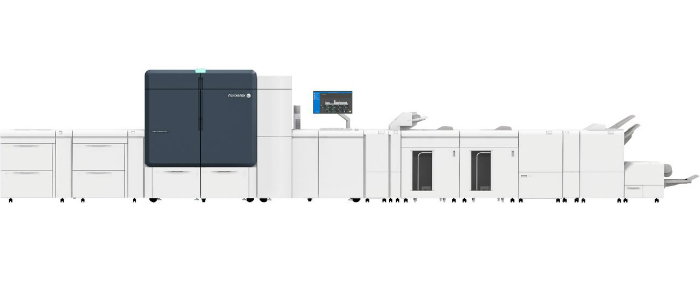
Fuji Xerox has released the Iridesse Production Press, which the company says is the industry’s first single-pass, six-colour print engine.
The press is available for purchase now.
Fuji Xerox says this new production printer with a six-colour print engine is able to print different specialty colours including metallic with a single pass, by housing up to two additional specialty dry inks of gold, silver, clear and white.
Fuji Xerox says fine and smooth images are made with 2,400 dots per inch fine resolution and HD EA dry ink, and Iridesse Production Press has a high productivity of printing on 400 grams per square meter thick paper at a high speed of 120 pages per minute.
The Iridesse Production Press can print images with the xerographic colour printing process by using up to two special dry inks selected from gold, silver and clear in addition to the common cyan, magenta, yellow and black (CMYK).
[Related: Fuji Xerox helping Adelaide go green]
Steve Green, Executive General Manager – Sales, Fuji Xerox Australia says, “Against the backdrop of rapidly diversifying consumers’ needs, the printing industry is adjusting its use of printing techniques.
“Instead of just relying on conventional offset printing, which performs well for high-volume jobs, more businesses are choosing on-demand printing, which is shorter in turnaround time and prints the necessary number of copies for catalogs, manuals, and advertising materials. Enhancing the value of print products with the use of their capital equipment, such as digital printers, is critical for printing companies to grow their businesses.
“As the industry leader, Fuji Xerox continues to enhance its product line to help our customers grow their business and uncover new markets,” continued Green. “Customers are looking for a new layer of personalisation, they want bespoke solutions at the speed of now. The Iridesse™*1 Production Press allows printers to deliver authentic, innovative solutions with flexibility and superior customer service.”
The company says, “White dry ink will also be added to the specialty dry ink line-up to accommodate printing on dark coloured or other specialty papers. Compared to prints using only conventional CMYK dry inks, adopting special dry inks expands the range of expression, produces a premium finishing and provides more sense of seasonality of the printed images, which adds value for effective marketing activities.
“The newly launched print engine enables CMYK dry ink layers to be processed on top of the special dry ink layer. In addition, an overlay of another specialty dry ink can also be processed on top of CMYK dry ink layers, which is a feature available with the previous product, the Colour 1000i Press. While conventional offset printing requires mixing silver ink to make metallic ink, this new product realises simultaneous printing of several metallic colours during a single printing process.”
CMYK dry inks are made of High Definition EA Dry Ink (HD EA Dry Ink)—what Fuji Xerox says is one of the world’s smallest particle size toners. The HD EA Dry Ink fuses quickly at low temperature and is evenly fused onto the paper by using the company’s marking technology that realises even transferring of six layer of dry inks.
Fuji Xerox says the standard colour library equipped in the product contains Pantone+Metallic and Pantone+Premium Metallic, which are swatches of metallic colours commonly used in the printing industry. By using these colour swatches, the operator can reproduce colours similar to Pantone metallic colours on printing materials by simply designating the colour codes.
The Fuji Xerox Finisher D6 with Booklet Maker, Crease/Two-sided Trimmer D2, and SquareFold Trimmer D1 can be connected to Iridesse Production Press to automatically produce professional booklets and folded leaflets. These finishing options expand the possible printing applications by enabling to produce complex folded leaflets including accordion-fold and gate-fold.
[Related: Steve Green joins Fuji Xerox]
Fuji Xerox says, “Against the backdrop of rapidly diversifying consumers’ needs, the printing industry is adjusting its use of printing techniques. Instead of just relying on conventional offset printing, which performs well for high-volume jobs, more businesses are choosing on-demand printing, which is shorter in turnaround time and prints the necessary number of copies for catalogues, manuals, and advertising materials.
“While offset printing involves significant time and cost for making plates, adjusting colours and proofreading, digital printing can process jobs with less time and cost and add value to printed materials. Enhancing the value of print products with the use of their capital equipment, such as digital printers, is critical for printing companies to grow their businesses. As the industry leader, Fuji Xerox continues to enhance its product line up to contribute to the growth of customers’ businesses.”
Comment below to have your say on this story.
If you have a news story or tip-off, get in touch at editorial@sprinter.com.au.
Sign up to the Sprinter newsletter
